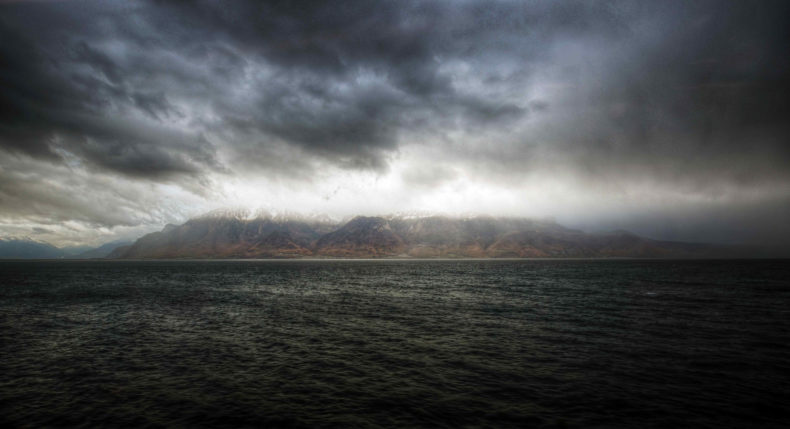Between two and three o’clock in the morning on June 16, 1816, during a restless night in a villa on Lake Geneva, eighteen-year-old Mary Wollstonecraft Godwin had a waking dream. As the moon shone through the shutters of her room, she remembered, “I saw the pale student of unhallowed arts kneeling beside the thing he had put together. I saw the hideous phantasm of a man stretched out, and then, on the working of some powerful engine, show signs of life …”
Over the next fourteen months, Godwin—later Mary Shelley—wrote her vision into life. The pale student became Victor Frankenstein, the hideous phantasm became his tortured creature, and Godwin became the author of the novel Frankenstein, published in 1818 and in print ever since.
Famously, Godwin’s inspiration arrived after she and her companions, who had spent most of their Swiss holiday trapped inside by extraordinarily cold, rainy weather, decided to entertain themselves with a ghost-story-writing contest. Lord Byron—already a noted poet and notorious cad—wrote a fragment about a dying explorer. The poet Percy Bysshe Shelley, Godwin’s lover and future husband, wrote a poem about atheism. Byron’s physician, William Polidori, wrote a poem about a vampire, which he later published under Byron’s name (and which, some argue, birthed the modern sexy-vampire story). The teenaged Mary Godwin outdid them all, creating both the first major work of science fiction and a story that disturbs us still.
Though Frankenstein’s most iconic scene may have come to Godwin in an instant, the story is rooted in her time and experience. When Godwin was fourteen, writes Richard Holmes in The Age of Wonder, her father took her to hear lectures by the renowned chemist Humphry Davy. Davy envisioned a future when humans would “interrogate Nature with Power,” words later echoed by the fictional Professor Waldman, who tells young Victor Frankenstein that the “modern masters … have acquired new and unlimited Powers: they can command the thunders of heaven, mimic the earthquake, and even mock the invisible world with its own shadow.” Some of Davy’s experiments with electricity inspired the proponents of Vitalism, who believed in the existence of an invisible life force—one that could, perhaps, be tamed and put to monstrous use by “modern masters.” Both Mary Godwin and Percy Shelley followed the vociferous public debate over Vitalism, and Frankenstein was a direct response to it.
The story of Victor Frankenstein’s doomed attempt to control the forces of nature may have also been inspired by nature itself, which in the summer of 1816 must have seemed malevolently out of control. Frost, droughts, and floods killed crops all over the world, and in the years that followed, millions of people starved. Millions more, weakened by hunger, died of cholera and typhoid fever. Villagers in Vermont subsisted on clover and nettles; veterans of the Napoleonic Wars, unable to feed themselves or their families, rioted throughout Europe. Farmers in Yunnan, China, hungry and desperate for cash, filled their fields with poppies, bloating the global opium trade. While some Vitalists might have dreamed of commanding the thunders of heaven, the thunders of 1816 bowed to no one.
The crisis, which lasted for nearly three years, was the source of both enormous suffering and great innovation, inspiring advances in agriculture, meteorology, and polar exploration. (The climatic disturbances included a sudden reduction in Arctic sea ice in 1817 and 1818, exciting would-be explorers; while some found success, many were as hapless as Frankenstein’s Captain Walton, who rescues Dr. Frankenstein after he pursues his creature into the Arctic). Historian Gillen D’Arcy Wood argues that the cycle of famines and plagues also led to an expansion of government responsibility for citizens and, in turn, to the modern concept of the state. In the realm of ideas, Wood observes, “sudden environmental dislocations act as an extraordinary stimulant.” Godwin, whose chilly Continental vacation stimulated a classic, might agree.
Not until the Cold War did climate scientists confirm that all these catastrophes—and triumphs—were caused by the April 1815 eruption of Mount Tambora in Indonesia, one of the largest volcanic eruptions in history. The cloud of sulfur dioxide released by the eruption shaded the earth, leading to a prolonged period of global cooling that disrupted the planet’s hydrological cycle. It was a natural experiment in geoengineering, and its results were catastrophic.
Two hundred years after Mary Godwin’s nighttime vision, Frankenstein can be read as both a warning of the perils of human hubris and a brilliantly imaginative response to a global disaster. As we enter another era of climate disruption—this time, a monster of our own making—we need both the reminder of the former and the inspiration of the latter.
Storm over Lake Geneva in Switzerland by Flickr user Mariusz Kluzniak. Creative Commons.

Michelle – Great insight into one of my favorite books. And a great piece of morning inspiration as I write a bit about the history of El Nino.